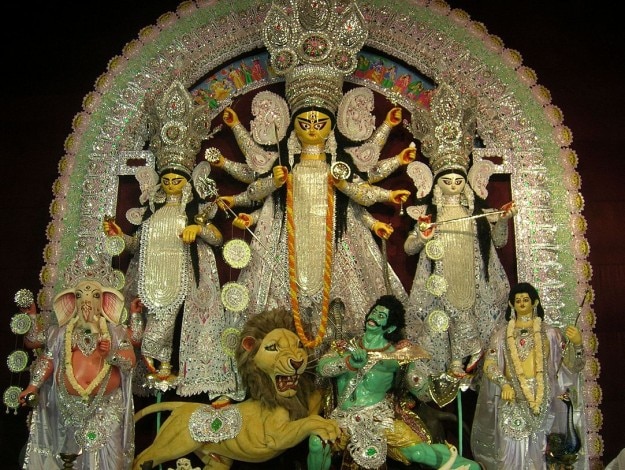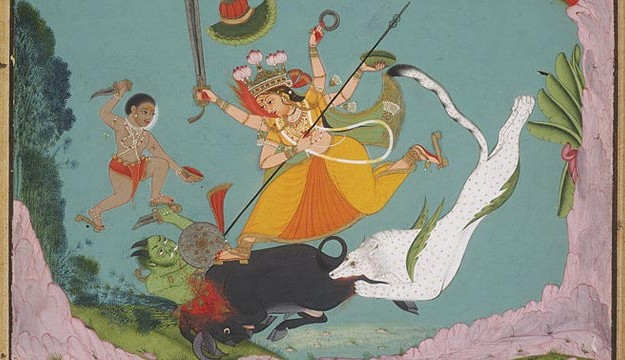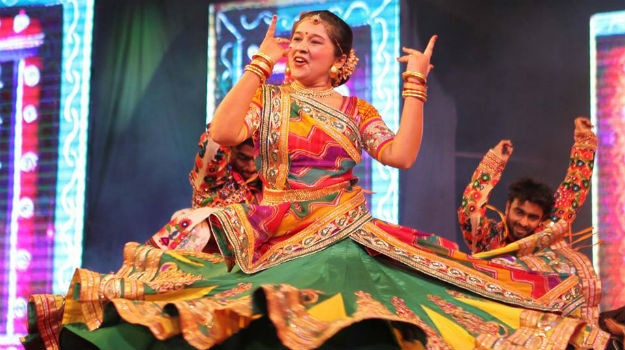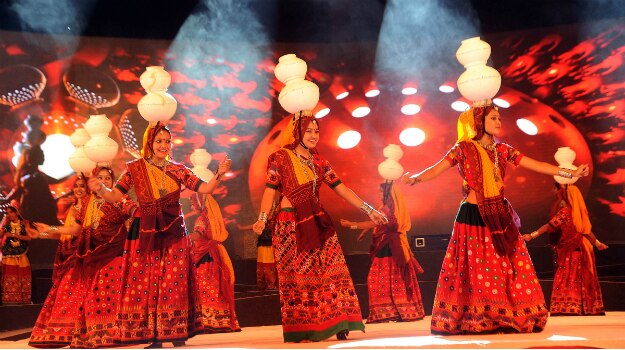Navratri 2017: Why and How is Navratri Celebrated in India?
by Pankaj Sharma Digital Marketing ProfessionalNAVRATRI STATUS IN HINDI:
॥ शुभ नवरात्री ॥
॥ जय माता दी ॥
॥ जय माँ शक्ति ॥
॥ जय अम्बे गौरी ॥
॥ ॐ ह्रीं दुं दुर्गाय नमः ॥
जोर से बोलो.. जय माता दी
|| ॐ ऐं ह्रीं क्लीं चामुण्डायै विच्चे ॐ ||
नमो नमो दुर्गे सुख करनी। नमो नमो दुर्गे दुःख हरनी॥
सारा जहां है जिसकी शरण में, नमन है उस माँ के चरण में.
हमको था इंतजार वो घड़ी आ गई.. होकर सिंह पर सवार माता रानी आ गई।
या देवी सर्वभूतेषु शक्तिरूपेण संस्थिता| नमस्तस्यै नमस्तस्यै नमस्तस्यै नमो नम: ||
लाल रंग क़ी चुनरी से सजा माँ का दरबार, हर्षित हुआ मन, पुलकित हुआ संसार, नन्हे -नन्हे कदमो से माँ आये आपके द्वार.
जगत पालनहार है माँ, मुक्ति का धाम है माँ, हमारी भक्ति का आधार है माँ, सबकी रक्षा की अवतार है माँ, शुभ नवरात्रि
देवी माँ के कदम आपके घर में आयें, आप ख़ुशी से नहायें, परेशानियाँ आपसे आँखें चुरायें, नवरात्रि की आपको ढेरों शुभ कामनाएं। शुभ नवरात्रि।
माँ दुर्गे, माँ अंबे, माँ जगदांबे, माँ भवानी, माँ शीतला, माँ वैष्णाओ, माँ चंडी, माता रानी मेरी और आपकी मनोकामना पूरी करे.जय माता दी.
सारा जहां है जिसकी शरण में, नमन है उस माँ के चरण में, हम है उस माँ के चरणों की धूल, आओ मिलकर माँ को चढ़ाएं श्रद्धा के फूल। शुभ नवरात्रि।
Navratri festival is celebrated to worship the nine forms of Goddess Durga, the Hindu Goddess of Power. It is a very important Hindu Festival and celebrated all over the country.
Here is everything that you need to know about Navratri 2017!
Navratri is just few days away and yet again it is that time of the year when nine days are spent dancing and celebrating. Navratri brings non-stop fun for nine days and being one of the most popular festivals of the country, it is celebrated by people all across the nation and even outside. It is more popularly celebrated in cities like Gujarat, Mumbai and also West Bengal. The fascinating part about this festival is that Navratri is celebrated five times in a year, unlike other festivals. However, the most important and the most celebrated of all is the Vasanta Navratri and also the Sharada Navratri. Celebrated in the honor of Durga, dance and music is the most important part about Navratri. The literal translation of Navratri is nine nights and in all these nine days Durga is worshiped since it is said that she embodies destruction, power and also preservation. Worshipping Durga is said to bestow devotes with immense wealth, prosperity and knowledge. During these nine days of fun, different forms of Goddesses are worshiped. The first three days, Durga is worshiped since it is believed that Durga destroys evil and the next three days, Lakshmi is worshiped who is said to be Goddess of wealth and prosperity. Saraswati is the goddess who is worshiped in the last three days of Navratri who is said to be the Goddess of wisdom.
Significance of Navratri:

Usually, the dates for Navratri are decided according to the lunar calendar and it is believed that the start of autumn and spring are considered to be auspicious and hence it is an apt time to worship Durga. This is the period when early autumn and spring are important junctions of solar influences and also climatic influences. This festival is also celebrated to symbolize power, the power of destroying evil. It is during Navratri, that a color code is followed all through the nine days. Each day has a color and usually people, especially women wear a dress of that color. This practice is followed all over, even at work places where this is a form of fun activity. People do it with so much passion and wholeheartedly, that the whole festive mood gets to you. This is also considered as an ideal to worship Shakti(Power).
History states that a whole chapter of the Rigveda has mentions of the devotions that have been made in the name and worship of Shakti. The Devi Sukta and also the Isha Sukya are praises sung of Shakti. In fact if you go back to mythology it is also said that before Pandavas and Kauravas waged war, Krishna had worship[ed Shakti so that the Pandavas emerge victorious in the war. Brahma is said to have mentioned in the Markandey Purana that the very first incarnation of Shakti was Shailputri, where as the other incarnations were Brahmacharini, Chandraghanta, Kushmanda, Skandamata, Katyayani, Kalaratri, Mahagauri and Siddhidatri and the incarnations happened in this order. And today it is these nine forms of Durga that are worshipped by people from all across the nation during Navratri.
These nine incarnations are also known as Nava Durga. The Shiva Purana also has a detailed description of these nine divine incarnations of Durga. The most important ritual or tradition followed during Navratri is the reciting of Gayatri Mantra. It is believed since the Vedic Age that Gayatri Anushthana as it is called is auspicious during Navratri. Fasting is also another very important ritual followed during Navratri.
Navratri 2016: Why and how is Navratri celebrated in India

Navratri starts from the first day which is the bright
fortnight of lunar month. Navratri is celebrated for nine consecutive nights,
usually at the start of October. Though the dates of this festival is dependent
on the Lunar calendar, Navratri may extend to a day more or may even be cut
down to a day less.
Day 1:
Pratipada which is the first day of Navratri is the day when the first incarnation of Durga, Shailputri is worshipped and revered. Shailputri literally means the daughter of mountains. And because Shailputri is another form of power, also known as Shakti, devotes worship and offer their prayers to this Goddess. Because it was a form of Shakti and also wife to Shiva, the bodies of Brahms, Vishnu and Shiva is what makes Shailputri. Like most Indian Gods and Goddesses have more than one name, even this form of goddess is called in different names like Hemavati, Parvati and Sati Bhavani. This day the color grey is followed and devotees who believe in these traditions and beliefs make it a point to wear grey clothes.
Day 2:
The second day of Navratri is known as Dwitiya. On this day the Goddess takes the form of a Brahmacharini and a Brahmacharini is the one who strictly and whole heartedly practices austerity. Also a form of Parvati and also Uma, it is strongly believed that the goddess blesses her devotees with prosperity, moksha and also happiness. This day the color orange is followed and you will see many ladies dressed up beautifully in orange.
Day 3:
On the third day also known as Tritiya, the goddess takes the form of Chandraghanta who depicts a perfect combination of beauty and bravery. The name Chandraghanta was given because of the half moon symbol on the Goddess’s forehead and this symbol looks like a bell also known as ghanta. Chandraghanta is a true symbol of strength and bravery to fight evil that in those times came in the form of demons. On the third day you wear the color white.
Day 4:
The fourth day of Navaratri is also known as Chaturthi. On this day the Goddess is worshipped in the form of Kushmanda. Now for those who are unaware, mythology says that Kushmanda is the Goddess who had created the whole universe only with her laughter. Now if these stories are anything to go by, then it indeed is a fascinating story. Usually if you haven’t noticed, this goddess always has eight to ten hands and on this day the color code is red.
Day 5:
The fifth day also known as Panchami is about Kartikeya who had led an army of Gods to fight the demons that were causing destruction in the world. And hence on this day, the goddess is venerated as Skandamata who is also Kartikeya. The goddess hat is represented shows a baby Skanda being held in one arm. The color code of this day is royal blue and you will see people dressed up in this color clothes. Some women also observe fasts on this day called as Lalita Gauri Vrat.
Day 6:
The sixth day is Shashti wherein devotes worship Durga in the form of Katyayani. There is an interesting story behind Katyayani. It is said and believed that a sage name Kata had performed many strict yagnas and prayers in order to get the goddess as his daughter. With much devotion and faith, he performed a long penance. Immensely impressed with such intense dedication, the Goddess granted him the boon that he always wished for. And several years later, Kata had a daughter who was named Katyayani and that is how this how Katyayni came into the world. On this day, devout wear yellow colored clothes which is the sixth day color code.
Day 7:
The seventh day of Navratri is popularly known as Saptami all over and on this day Kalratri is worshipped. Kalratri means the dark night. The Goddess has a very aggressive expression and posture with unruly hair and a dark complexion. It is believed that praying to this Goddess will help you stay safe from any kind of troubles or fears and unlike other manifestations of Durga, Kalratri is depicted riding a donkey and not a lion. On Saptami, people wear white and because the Goddess is also popularly called Shubamkari- the one who only does good, white symbolizes the same. Many people also do Sarwastwai Puja on this day since it is considered to be highly auspicious. The color for this day is green.
Day 8:
The Eighth day also called Ashtami is the day when Maha Gauri is worshipped. Being the eighth avatar of Durga, according to legend it is said that it was Maha Gauri who liberated the whole world from the bad and evil forces. The idol of Gauri usually has three eyes and four hands and the lower hand usually is seen holding a trishul. The left lower hand depicts her granting blessings to her devotees. Maha Gauri is well known to be fair as milk and is often compared to conch, white flower and also the moon. More often than not, the Goddess is depicted in a white or a green saree and is seen riding a bull. Also popularly known as Shwetambardhara, it is said that offering your prayers to Maha Gauri will help you attain peace and take away all the sorrows from your life. The color followed on this day is peacock green.
Day 9:
The last day – Navami is in dedication to the last avatar of Durga- Maa Siddhidatri. Devotees believe that offering their prayers to Siddhidatri means getting to achieve whatever they have wished for. Siddhidatri has the power of granting 26 wishes also known as Siddhis. And if the stories are anything to go by it is said that Shiva has got these Siddhis because he dedicatedly prayed to Shakti. This Goddess sits on a Lotus and rides a lion and has four hands, each hand holding something symbolic like a lotus, a chakra and also a Shankha. The ninth day marks the end of Navratri and people from all over pray to this Goddess. It is said that if pleased, she grants all the 26 wishes of her devotees. This Navratri, do not forget to be a part of such beautiful celebrations and traditions. People wear purple on the last day.
These are the nine different forms of Durga that are worshiped by devotees from all across the nation. And like you read, each of these manifestations of Durga has a meaning and history attached to it. You need to be a part of it to believe such beautiful and fascinating Hindu traditions. Since Navratri is also a lot about dance and music, let us also take you through the different dance forms that are practiced during Navratri. Dandiya and Garba are the main two forms of dance that are seen.
States like Gujarat and Mumbai put up a fancy and grand show of these dance forms. If you want to experience dandiya nights in the best possible way, Gujarat or Mumbai is where you should be. And you wouldn’t believe us that Mumbai and Gujarat both line up imminent artists for performances. The vibrancy and enthusiasm of Dandiya nights should be experienced at least once in a lifetime. Before you put on your dancing shoes already, you might want to know a little about Dandiya Raas and Garba Raas.

Think of Navratri and the first thing that comes to
anybody’s mind is Dandiya. Navratri is truly incomplete without this dance
which is usually done to the peppy beats of dhol, traditional songs and songs
performed by artists live. AparT from this, what sets the whole look and feel
are women who walk in decked up in stunning traditional clothes which is also
known as ghagra choli. This is a sight to behold! Dandiya is performed in
dedication to Durga and not many might know, but Dandiya is a mock
representation of the fight between Goddesses and Mahishasura who was a demon
killed by Durga.
Though, there does exist several types of Raas; Dandiya Raas is performed only during Navratri. And Dandiya is dancing in groups forming a circle with sticks. The circle keeps moving in coordinated steps to the beats of the music. There are many professional dancers who practice well in advance to perform during Navratri. The energy of the dancers is a sight that will leave you stunned. You do not have to be in a group of only people know n to you. Usually during Navratri, people randomly join groups and dance in rhythm.
Another form of dance is the Garba which is also pretty similar to Dandiya, the only difference being that Garba Raas is performed without sticks and is usually done before the aarti has been done. If you go to any popular place that organizes Dandiya nights, you will see that the ones who are well versed with Garba do it in a fast pace, something that a non dancer might not be able to do. But there are also several people who do slow form of Garba.
In Gujarat, Garba is usually performed around the earthen lamp which is also called the Garba Deep. This lamp represents a human body that is said to have divinity within it. In fact have you ever thought why this dance form, both Dandiya and Garba is done only in circles? The circle means the Hind perspective of time and life. Life keeps progressing from birth to life, then death and rebirth. But in this the whole process, the only thing that remains constant is the Goddess or any divine form. It is one of the most colorful dance forms and if you want to witness some of the best Garba Raas, you must visit Vadodara which is the cultural capital of Gujarat and has one of the best dandiya and garba events.

Apart from Mumbai and Gujarat, there are other states also
that surprisingly celebrate Navratri in a unique form. It may not be as
elaborate and grand as other cities, but they are nothing short of fun and
energy. And here we are talking about Thiruvananthapuram that hosts the
Navratri Music Festival.
It might not be as authentic as Dandiya and Garba Raas,
however this festival in Trivandrum does put up a good show of both culture and
music. Known as Swathi Sangeethotsavam, the Navratri Music Festival is
held inside the East fort at the Navratri Mandapam. The difference between the
usual Dandiya and this one is that for nine long days, Thiruvananthapuram comes
to life with Carnatic music. Music artists from all over South India visit the
capital to be a part of this music fiesta. Meanwhile, there are others who come
only to experience and witness this beautiful musical experience. On each day
of this festival, nine keerthanas as sung in varied ragas which are considered
to be the main part about the festival in Thiruvananthapuram. The keerthanas is
said to have been composed by Swathi Thirunal who was the Maharaja of
Travancore. This festival is open to all, but there are small restrictions that
need to be followed since it is held in a temple.
Dhunuchi Dance: Another exciting thing that Navratri brings with it is the Dhunuchi dance. The sight of Dhunuchi dance remains unparalleled and it is done during Durga Puja. This dance form is mostly seen in Bengal and it is performed at dawn after the puja and aartis are done. Dancers hold a clay pot that has burning coconut shells and sometimes even coals. They dance holding this pot in from of the Durga deity. The whole aura of this dance is a sight worth watching. Iy might look easy, but it require skill to perform the Dhunuchi dance while also maintain the rhythm.
This is how Navratri is celebrated all across India. Each state has a distinct way of celebrating, but where ever you plan to go, you are definitely going to have a memorable experience. Do not forget to put in your dancing shoes to twirl and whirl to the beats of Dandiya music.
Sponsor Ads
Created on Dec 31st 1969 18:00. Viewed 0 times.




